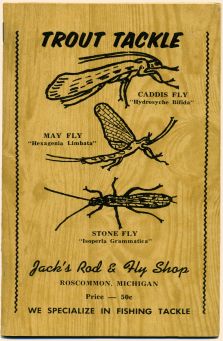Tiny Flies
By Neil M. Travis, Montana
The dog days of summer bring low flows, crystal clear water,
and hatches of tiny flies on many trout waters. My introduction
to this type of fishing came over 40 years ago on Michigan's
Au Sable River. Starting in late July and continuing until
early September hatches of tiny flies often carpeted the
water, and trout noses could be seen poking through the
surface film as far as the eye could see. Considered a
curse by many anglers I fell in love with this type of
angling, and it is a love affair that I still have today.
The Au Sable had prolific hatches of midges, tiny black midges
that we tried to imitate with flies we purchased from Jack's
Fly Shop in Roscommon. Jack and Ann's fly shop was just outside
of town, and Ann tied all the flies herself.
 She tied midges in size 18 and 20, and in the 1960's you could
buy them for fifty cents apiece. In the days before I was tying
all my own flies I would buy a half dozen tiny black ones and
set off to try my luck.
She tied midges in size 18 and 20, and in the 1960's you could
buy them for fifty cents apiece. In the days before I was tying
all my own flies I would buy a half dozen tiny black ones and
set off to try my luck.
It was later that I was introduced to the truly great small
fly hatches that the Au Sable produced. Tricorythodes stygiatus,
these tiny black and white mayflies are a true size #28, and in
those days they hatched in phenomenal numbers. The best fishing
was from daybreak until about ten o'clock in the morning. Success
was not counted in numbers of fish caught or even hooked since
the fish could be extremely selective. Since the flies hatched
in such prodigious numbers trying to get a fish to sip in your
offering was often more a matter of luck than skill.
Tricos, as they are commonly called today, are an interesting
insect. The nymphs live in the detritus, the rotting leaf litter
found in the quite backwaters, and their bodies are covered with
hairs that collect bits of decaying vegetation causing the nymphs
to look like a small moving pile of debris. When they hatch they
almost immediately molt into the imago or spinner form, and
immediately begin their mating dance. When the hatch is heavy
the spinner flights of the adults look like fog or mist just
over the water. While trout eat the nymphs and the duns the
best fishing is during the spinner fall. Generally it lasts
longer, and the tiny spinners are easy picking.
Pseudocloeon anoka, a tiny greenish-gold mayfly, now renamed
Plauditus puntiventris, are another tiny mayfly that hatch
during the mid to late summer, except rather than hatching
at dawn they hatch late in the afternoon with the spinner
fall coming right at dark. They are not quite as small as
T. stygiatus, only a size 24, but in the fading light of
mid-summer it takes a good pair of eyes to see your imitation
on the water. The trout always seemed to like these little
mayflies, and JC and I had some memorable evenings on the
Au Sable fishing to trout rising to these tiny green jewels.
When I moved to Montana in the early 70's I discovered an entire
new cast of tiny flies on the local spring creeks and even on some
of the larger freestone streams. We have tricos, a number of small
olives in the Baetis family, and many small sulphurs. Midge hatches
on many of our rivers far surpass anything that I ever witnessed on
the Au Sable, but I still have fond memories of those tiny flies
that so long ago started me on a fishing odyssey that continues to
this day. ~ Neil M. Travis, Montana/Arizona
From A Journal Archives
|

